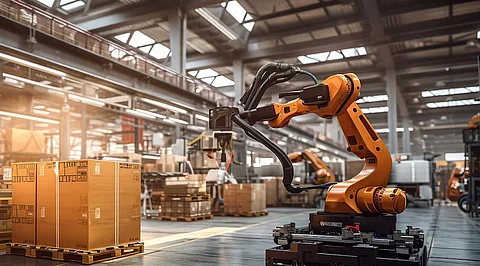

Efficiency has become important in today’s global commerce. Shipping ports and companies are challenged to deliver goods quickly, effectively, safely, and cheaply. The shipping industry has seen transformational changes because of technology. Today's ports utilize the latest container-handling technologies, such as automated cranes and drones. This article researches the application of robotics and automation concerning the future of shipping, including the design materials for the containers and their sustainability.
The most significant advancement in the handling of shipping containers is the creation of automated cranes. These cranes are built to lift and stack containers with as little interference from humans as possible. Automated cranes incorporate sensors, cameras, and GPS systems, allowing movements and placements to be done accurately. These cranes are reshaping port activities by minimizing doses of human error and boosting operational rhythm, culminating in more effective functioning of the port’s infrastructure.
In the container, handling arms can still hold conveyor belts in the same respect. These systems can sort, move, and load containers without manual labor. Reducing the physical elements of the process also accelerates the tempo of performing loading and unloading, increasing the overall safety of quay personnel as they are less exposed to risk.
The rapid adoption of autonomous mobile vehicles in logistics and shipping has automated manual processes, significantly improving efficiency. Ports now utilize self-driving trucks and shuttles to ferry containers among cranes, storage places, and ships. These vehicles move around the port area with the help of advanced sensors and navigation systems for safe and efficient movement.”
Benefits of self-driving trucks include:
Enhanced Productivity: These vehicles improve productivity because these trucks do not need to stop working day and night.
Lower Labor Costs: Ports can use fewer employees while assigning the remaining ones to more occupational suitable positions.
Enhanced Safety: Such vehicles reduce accidents, resulting in human mistakes.
Consolidated Structures for Effortless Functioning Automation and robotics are most effective when incorporated into a unified management system. Smart ports deploy cutting-edge technologies such as artificial intelligence and data analysis to monitor and control all real-time automated processes. This level of integration allows for better interaction with other elements, such as cranes, vehicles, and storage facilities. Each component can communicate with the other, increasing efficiency in port operations.
An example of how AI, new payslips, or algorithmic predictions is estimating the maximum expected volumes of incoming cargo. Other cases would be maximizing cubital content stored or ensuring the most efficient loading and unloading order. Such highly sophisticated algorithms enable smart ports to operate at maximum efficiency without falling victim to having too much information.
Understanding the creation of the shipping container is important for durability and longevity. The containers are made of Corten Steel, better known as weathering steel, the most durable material. The alloy has improved anti-corrosion properties, enabling it to withstand severe marine environments.
Other materials aside from Corten Steel are used to boost the performance of containers:
Sealants: Corten steel containers undergo various sealing processes to ensure watertightness. Waterproofing rubbers and anti-corrosive materials guarantee the container's resistance to rust.
Plywood Flooring: The floor of most shipping containers is made from sustainably sourced plywood or alternative materials procured from sustainable sources. These materials are highly selected due to their strength, durability, and eco-friendliness.
Containers are useful worldwide because they smooth out the rough handling, extreme weather, and long sea journeys that are all a part of global trade.
Sustainability in Shipping Container Construction is a hot topic in shipping. Many manufacturers are on the lookout for attempts to use eco-friendly materials, including changing construction methods to minimize environmental harm. For example, using sustainably sourced plywood or alternative materials for container flooring helps attain a structural balance while conserving natural resources.
Repurposing old shipping containers is another sustainable practice slowly gaining traction. From shipping containers, waste can be eradicated by converting them into homes, offices, and even retail outlets – and this certainly gives containers a second life.
Although there are several advantages concerning automation and robotics, the downside is the emergence of certain problems, especially cybersecurity. Regarding infrastructure and appliance autonomy, robotics requires a high initial investment, which can significantly hurt a business's budget. Adapting systems alongside trained employees also requires stepping out of comfort zones.
Cybersecurity is yet another factor to reflect on. Automated systems operate in a networked environment, making them susceptible to cyber-attacks. Ports must spend money on bulk cybersecurity to support their operations and information.
If you are curious about the construction details and the CMG shipping container innovatively, go to the CMG Containers website now. CMG Containers offers various services for companies and people who wish to rent, buy, or modify shipping containers.
The shipping industry is witnessing a wave of transformation owing to the increased use of automation and robotics in port operations, which is making them faster, safer, and more efficient. The future of container handling is promising, considering the automated cranes, autonomous vehicles, and advanced materials with sustainable features being introduced into the field. As technology advances, ports and shipping companies must utilize these practices to remain relevant in the competitive international economy.
Whether you work in the shipping industry or are a technology enthusiast, knowing about the sophisticated innovations will enable you to appreciate modern-day logistics. To understand how trade and sustainability are interconnected through shipping containers, visit CMG Containers's website.
